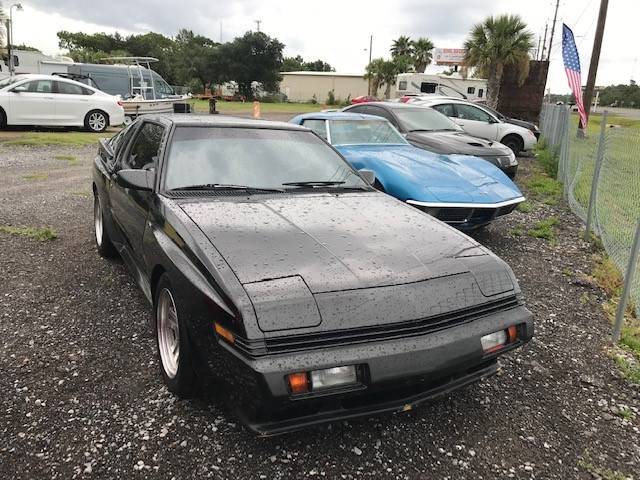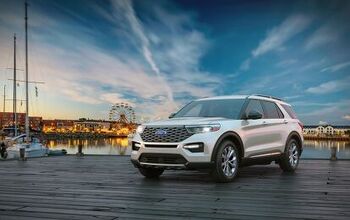Rare Rides: The 1988 Chrysler Conquest - an American Sports Coupe

Quick badge swaps between Chrysler and Mitsubishi were common throughout the Eighties. Mostly a one-way affair, Chrysler rebranded Mitsubishi products as Colts, Plymouths, and Dodges. These captive imports generated revenue via Chrysler’s brand recognition while cheaply filling gaps in the domestic company’s lineup.
Today marks our first Chrysler-branded Mitsubishi, and it’s certainly the sportiest rebadge we’ve seen here. Presenting the Chrysler Conquest, from 1988.
Chrysler existed without a sports car in its portfolio for the early part of the Eighties, but did sell the Mitsubishi Galant Lambda as the Dodge Challenger and Plymouth Sapporo. Those offerings ended in 1983, and in 1984 Chrysler received its own sporty car in the front-drive Chrysler Laser. That same year, Dodge received its own Laser version, as well as Mitsubishi’s Starion (as Conquest), which Mitsubishi sold on North American shores since 1983. Chrysler had to make do with the Laser as its sole sports offering until 1987, when the Conquest moved mildly upmarket for its duties at ChryCo’s finest showrooms.
Fitting its sporty mission, all examples of the Starion and Conquest were turbocharged, making use of inline-four Mitsubishi engines. Displacement options were of 2.0 or 2.6 liters, and power was transferred to the rear through a four-speed automatic or five-speed manual. Starion was based on a revised version of the Galant Lambda platform, serving as its direct successor.
There were two different body styles of Conquest, due to Japanese regulations on size. Early models were all the “narrow body,” with a 66.3-inch width. That width (and the 2.0-liter engine) qualified for a lower tax bracket. As the Starion had branched out to the American market, half way through 1985 Mitsubishi made a concession and debuted a wide-body version. Overall width grew to 68.7 inches.
But the product differentiation didn’t stop with a width adjustment. Narrow versions were now considered the entry model, and went without an intercooler on the turbo. Wide body versions had an intercooler, and most often used the larger 2.6-liter engine. Denoting the upmarket models were ESI-r badges for the Starion, and TSi markings on the Conquest. Upon the introduction of the TSi in North America, the narrow body cars were called Technica. In select markets which didn’t receive any wide-body cars, there was a concession: a more powerful ESI-r trim in narrow body format. Power figures ranged from 150 to 197 horses depending on region, turbocharger, intercooler option, and number of heads (eight or 12).
Mitsubishi continued to fiddle with things like wheel lug count and axles for the remainder of the Conquest’s run. Things got narrower for the wide body in 1988, with a decrease to 68.3 inches. That same year the car was lowered by nearly two inches, thus completing its final look. 1989 marked the last year for Conquest and Starion, as their American-made DSM successors — Plymouth Laser and company — were ready for 1990.
Today’s black-on-black Conquest TSi is in very rare form with low miles. Located in Florida, it asks $6,999.
[Images: seller]

Interested in lots of cars and their various historical contexts. Started writing articles for TTAC in late 2016, when my first posts were QOTDs. From there I started a few new series like Rare Rides, Buy/Drive/Burn, Abandoned History, and most recently Rare Rides Icons. Operating from a home base in Cincinnati, Ohio, a relative auto journalist dead zone. Many of my articles are prompted by something I'll see on social media that sparks my interest and causes me to research. Finding articles and information from the early days of the internet and beyond that covers the little details lost to time: trim packages, color and wheel choices, interior fabrics. Beyond those, I'm fascinated by automotive industry experiments, both failures and successes. Lately I've taken an interest in AI, and generating "what if" type images for car models long dead. Reincarnating a modern Toyota Paseo, Lincoln Mark IX, or Isuzu Trooper through a text prompt is fun. Fun to post them on Twitter too, and watch people overreact. To that end, the social media I use most is Twitter, @CoreyLewis86. I also contribute pieces for Forbes Wheels and Forbes Home.
More by Corey Lewis
Latest Car Reviews
Read moreLatest Product Reviews
Read moreRecent Comments
- Analoggrotto Does anyone seriously listen to this?
- Thomas Same here....but keep in mind that EVs are already much more efficient than ICE vehicles. They need to catch up in all the other areas you mentioned.
- Analoggrotto It's great to see TTAC kicking up the best for their #1 corporate sponsor. Keep up the good work guys.
- John66ny Title about self driving cars, linked podcast about headlight restoration. Some relationship?
- Jeff JMII--If I did not get my Maverick my next choice was a Santa Cruz. They are different but then they are both compact pickups the only real compact pickups on the market. I am glad to hear that the Santa Cruz will have knobs and buttons on it for 2025 it would be good if they offered a hybrid as well. When I looked at both trucks it was less about brand loyalty and more about price, size, and features. I have owned 2 gm made trucks in the past and liked both but gm does not make a true compact truck and neither does Ram, Toyota, or Nissan. The Maverick was the only Ford product that I wanted. If I wanted a larger truck I would have kept either my 99 S-10 extended cab with a 2.2 I-4 5 speed or my 08 Isuzu I-370 4 x 4 with the 3.7 I-5, tow package, heated leather seats, and other niceties and it road like a luxury vehicle. I believe the demand is there for other manufacturers to make compact pickups. The proposed hybrid Toyota Stout would be a great truck. Subaru has experience making small trucks and they could make a very competitive compact truck and Subaru has a great all wheel drive system. Chevy has a great compact pickup offered in South America called the Montana which gm could make in North America and offered in the US and Canada. Ram has a great little compact truck offered in South America as well. Compact trucks are a great vehicle for those who want an open bed for hauling but what a smaller more affordable efficient practical vehicle.






































Comments
Join the conversation
This is my favored JDM coupe ,based on looks alone, or perhaps tied with an FD Rx 7
I thought they looked so cool, and wanted one badly. The prices were high so stuck with the Daytona and Shelby Chargers. Finally one came along I could afford. I loved that car, but the electronics were a nightmare.. this is such a great looking car